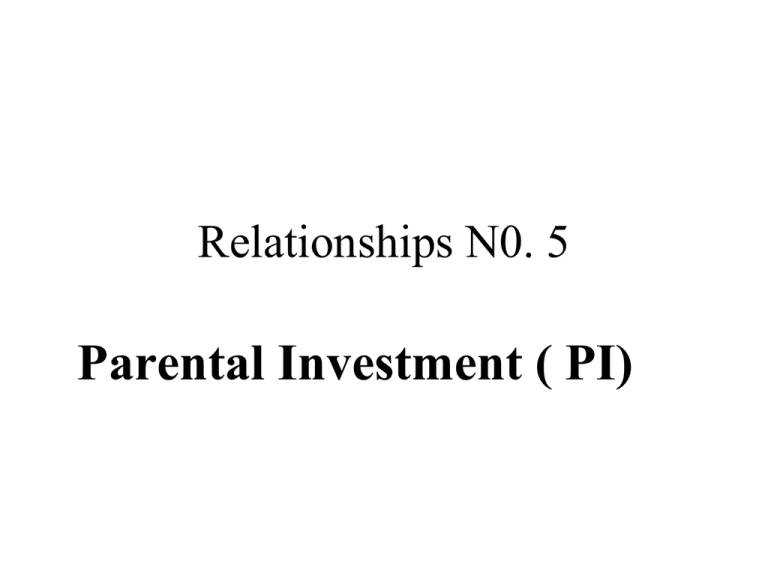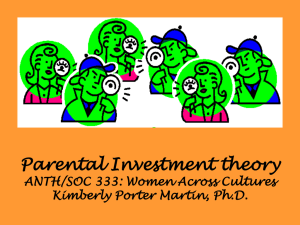
Relationships N0. 5
Parental Investment ( PI)
Trivers 1972 – Parental Investment Theory
• “Any investment by a parent in an
offspring that increases the chance that
the offspring will survive at the expense
of that parent’s ability to invest in any
other offspring (alive or yet to be
born.”)
Unequal Parental Investment
• In most species males and females do not invest
equally in their offspring. Females investment is
greater because female eggs are less numerous
and more “costly” to produce than male sperm.
A female can only have a limited number of
offspring whereas in theory, a male can have an
unlimited number.
• As a result of this biological inequity, females
must be much choosier concerning potential
mates. Males compete for quantity of females,
whereas females select for quality of males and
their resources.
Sex Differences in Parental Investment
• The most obvious difference is that human males
can opt out of parental investment in a way that
females cannot.
• Daly and Wilson 1978 –: By expending a
relatively large part of their reproductive effort
on courtship and mating, males of most species
can afford to devote rather little in comparison,
to parental care.
• HA!!
How do Human Females invest More?
• Human brain size increased in response to adaptive
pressures among our ancestors. This resulted in more
difficult childbirth because of the enlarged skull. So to
compensate for this, childbirth in humans occurs earlier
in development which means that human infants are born
relatively immature compared to other animals.
• Like other mammals, human females breastfeed their
young and so are burdened by the extended period of
childcare that results from this prolonged immaturity.
SO – human mothers make a greater prenatal
contribution of resources (long pregnancy, dangerous
labour) and a larger postnatal contribution too.
The Costs of Maternal Investment
• For Our females ancestors, the minimum
parental investment would have been a ninemonth pregnancy followed by years of feeding,
carrying and caring.
• For Our male ancestors, (and for some
irresponsible 21st century males!!) the minimum
parental investment would have been a few
moments copulation and a teaspoonful of semen.
• This means that there is an enormous difference in
the potential reproductive success of the sexes,
making random mating for females very costly.
Commentary on Maternal Investment
• There are Two consequences for this high
maternal investment.
• 1. Females need male providers.
• 2. The huge expense of child rearing (in
terms of time and effort) means that females
want to ensure good quality offspring. – But
how is this achieved with maximum
effectiveness?
• WELL!! This is interesting!!!
One Way!
• Is to marry a man who has good resources and is
caring. BUT THEN
• Shop around for good genes though extramarital
affairs with “studs” – attractive men “advertising”
good genes but no resources. Then you have the
best of both worlds from an evolutionary point of
view.
• In a magazine survey of over 2,700 UK women,
Baker and Bellis, 1990, estimated that as many as
14% of the population were products of
extramarital mating.
Paternal Investment and Cuckoldry
• When males do invest parentally, for example
through their resources, they are under pressure
to protect themselves from the possibility of
cuckoldry. (investing in offspring who are not
their own)
• For this reason, according to Miller 1998 men
have a greater concern than females, about the
fidelity of their mates. Adultery laws,
(traditionally drafted by males) have been
harsher on women than on men, and even today
in some parts of the world, a woman’s adultery is
punishable by death.
Sexual and Emotional Jealousy
• The possibility of sexual infidelity posed different
adaptive problems for males and females.
• A man whose mate was unfaithful risked investing
in offspring that were not his own.
• A woman whose mate was unfaithful risked losing
the man’s resources for her and her family.
• Buss 1995 said this is why sexual jealousy evolved.
• Men are jealous of their mate having sex with
someone else (because of cuckoldry) whereas:• Women are more jealous of a perceived shift in their
mate’s emotional focus (because of consequent loss
of resources)
Commentary: Evidence for Sex Differences in
Jealousy
• Buss et al 1992 found that US male students
indicated more concern about female sexual
infidelity , whereas female students expressed
more concern over male emotional infidelity.
• This was supported by physiological responses
when students were asked to imagine scenes of
sexual and emotional fidelity.
Shared Parenting – Dunbar 1995 suggests that it pays male
humans to restrict their reproductive opportunities and
invest more in each individual offspring as this can
increase the success of childrearing. And joint parental
care is of evolutionary advantage because of the high
costs of successful reproduction.
Research Study: Sex Differences in
Parental Investment
• In 2008, Conservative M.P Michael Gove
claimed that “lad mags” such as Zoo and Nuts
encouraged a shallow attitude to women and
linked such mags to a rise in feckless fatherhood
and family breakdown. Is this true or are male
attitudes to parenting shaped more by biological
forces as predicted by the Parental Investment
Theory?
Geher et al 2007
• Studied 91 non-parent heterosexual
undergraduates.
• Each completed a parental investment perception
scale after being exposed to various parenting
related scenarios such as “You are the parent of a
three-year-old girl who has an ear infection. Your
plans for the day have completely changed, as you
now have to look after her”.
Findings of Geher et al 2007
• There were no gender differences in the self-report
responses on the P.I perception scale BUT
• There were clear gender differences in ANS arousal
to the different parenting scenarios.
• Males showed significantly increased heart rate
when presented with scenarios that emphasised the
costs of parenting (e.g. that they would be unable to
work)
• Researchers concluded that, consistent with
predictions from the PI theory, males are
biologically less prepared than females to confront
issues associated with parenting.
Parent – Offspring Conflict
• So far we’ve looked at the idea of parental
investment as if the offspring were
completely passive in the process. But this is
not the case.
• The resource allocations that would
maximise parental fitness are not necessarily
identical to those that would maximise
offspring fitness.
Trivers 1974 argues that this results
in the following predictions:
• Parents and their children will be in conflict about when
the child should be weaned, with the parents generally
wanting to wean the child sooner to free themselves of this
time-consuming and costly activity and the child wanting
to receive milk for longer in order to ensure healthy
growth.
• Parents encourage children to value siblings more than
they are naturally inclined to as friendly siblings will share
resources, ensuring that all grow healthily with a better
chance that the parent’s genes are perpetuated, and freeing
the parents to invest in younger and therefore more needy
siblings . But in reality siblings are competing for
resources.
An Evolutionary Perspective
• According to the PI theory, parents maximise their
reproductive fitness by gradually withdrawing their
investment from older children in favour of
younger siblings. First and last-born siblings hold
a privileged status with respect to parental
investment.
• First borns are closer to reproductive age, when
their (and the parents’ genes) will be perpetuated
• Last-borns need more caring for as they compete
for resources amongst the older, stronger siblings.
This hypothesis is supported by
Andrews 2006
• Analysed responses from a survey of 1600 US
adolescents.
• Results showed that severe suicide attempts were
significantly more common among middle-born
compared to first and last-born children.
• This study supports the view that that suicidal
behaviour may be an adaptive response in line
with the predictions of the PI theory and that
middle-borns would make risky suicide attempts
in an effort to extort increased investment from
parents.
More Parent – Offspring Conflict
• Conflict Before Birth – Some pregnant
women suffer from a potentially fatal
condition – Pre-eclamsia, which is a
dangerous rise in the mother’s blood
pressure caused by the foetus secreting
hormones in an effort to get more nutrition.
It serves the foetus well as it does get more
nutrients and is an adaptive mechanism
which benefits the foetus at the expense of
the mother.
Commentary - Conflict Before Birth
• Research has shown that mothers who do have
high blood pressure during pregnancy tend to
have fewer spontaneous abortions and larger
babies at birth.
• So this suggests that high blood pressure is
associated with more healthy foetuses and so is
an adaptive strategy for the child. A risky one
though, as pre-eclampsia can kill pregnant
woman therefore putting the foetus at risk.
More Parent – Offspring Conflict
• Conflict After Birth – When their offspring are
young and helpless it is in the interests of the parents
to invest more of their resources in these offspring
and less in their older, stronger brothers and sisters.
• When these babies become older and stronger,
parents can maximise their own reproductive fitness
by directing their limited resources towards the
younger offspring and away from the older child.
• Parent-offspring conflict is often most intense at this
transfer stage, as the older children attempt to
prolong the parents’ primary focus on them for as
long as possible.
Commentary - Conflict After Birth
• Salmon and Daly 1998 argue that many younger
children don’t bother to compete with their older
siblings but instead, opt out of competition for
parental attention altogether and develop traits
such as cooperativeness to help them form
alliances with non-relatives, which could be a
useful evolutionary strategy .
• And younger children do tend to be more
cooperative. But Shaffer 1993 suggests that this is
learnt through having to negotiate with older
siblings.
More Parent – Offspring Conflict
• Sibling Rivalry – In most sexually reproducing
species including our own, offspring will want
more than their “fair share” at the expense of
their siblings in order to maximise their own
fitness.
• As a result sibling rivalries develop as children
compete for the attention and resources of
parents.
• Can you think of any advantages/disadvantages
of being an only-child?
Commentary - Sibling Rivalry
• Lalumière et al 1996 suggest that a powerful
parental strategy to cope with sibling rivalry is to
steer siblings along different paths, maximising
each individual’s strengths, so that there is less
sibling competition and also less subsequent
competition for the same mates.
------------------------------------------------------------• Homework – Discuss evolutionary explanations
for sex differences in parental investment and
parent-offspring conflict.
• 9 marks + 16 marks







